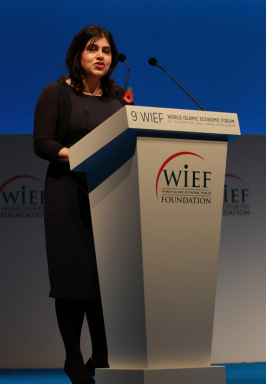
To conclude this first ISFIRE Insight, Mr Neil Miller, Global Head of Islamic Finance at Linklaters, sets out his expectations for the global sukuk sector in the coming year. As a veteran with nearly 20 years of experience in the industry, and of structuring sukuk, Miller affords us an unparalleled insight into the state of the industry and gives us his opinion on how to build sukuk’s momentum, particularly with relation to government finances.
As 2013 ended, the sukuk market was bubbling in anticipation. The final outturn for the year may not have matched the absolute volume of sukuk issuance during the preceding calendar year (2012 was itself a record-breaking year) but there was nevertheless a sense of palpable excitement in the air. And whilst 2013 may also be the year when the sukuk industry can finally claim to have come of age – we shall discuss some of the developments that give us cause to say this – the sector still remains sub-scale. So the key challenge of 2014 will be how to build upon the momentum of 2013 and propel the sukuk market towards sustainable volumes of issuance in more of its key markets.
Liquidity evolves
Available investor liquidity seems likely to remain a theme in 2014, particularly in the Gulf Cooperation Council (GCC) region. Barring extraneous events we can also expect sukuk pricing to remain competitive with conventional bonds, with issuers often being able to price sukuk at tighter margins to a comparable conventional bond issue.
After much delay, the International Islamic Liquidity Management Corporation (IILM) finally conducted a successful auction in August. The IILM issue was designed to provide a short-term instrument on a cross-border basis that Islamic financial institutions can utilise to assist their liquidity management. In effect, the first auction proved the concept of the scheme, but the challenge will be to ensure a stream of future issues in which all of the central bank member state shareholders participate. These instruments do not need to be tradable themselves but they must be issued regularly and consecutively if they are to provide the support envisaged in their design to the wider Islamic financial services industry. This article was being prepared as news of a second issue was awaited.
Governments ho!
Ignoring for a moment the IILM approach, one of the continuing challenges in the sukuk space remains the lack of the right sort of ongoing unilateral issuance by governments in the Muslim or Muslim-majority world. The reasons are perhaps threefold: at one end of the spectrum there are governments running budget surpluses that do not need to borrow; at the other end there are governments that simply cannot obtain credit ratings to support issuance. However, a further problem is a technical challenge that nobody has yet satisfactorily solved or implemented: how can governments raise Shari’a-compliant general purposes funding on a cost-effective basis, where assets are constrained?

The recently developed methods are increasingly being deployed by financial institutions (who often face a similar challenge) and corporations take many different forms and demonstrate the increasing maturity of the industry suggested in the opening remarks. In the financial institutions sector, 2013 witnessed the continued development of various types of cashflow and/or hybrid sukuk together with perpetual issuances that also qualify for Basel III purposes as Tier One capital. In the corporate sector, the appearance of ‘asset-lite’ sukuk based on outputs and developing the ‘airtime’ technology of the telecoms sector saw Emirates issue sukuk based on a measurement of route capacity known as ATKMs. We have also witnessed the development of corporate hybrid deal structures. At the moment these methods may not seem capable of readily translating into the public sector, but this is a subject to which we shall return shortly.
Will 2014 be a year of demonstration?
If the governments of countries such as the United Kingdom, Hong Kong, South Africa, Luxembourg and Ireland can deliver on intimations that sukuk will be forthcoming, then 2014 could be the year of catalytic change for the sukuk industry. The front runner must now be the United Kingdom in light of the powerful statement made by the British Prime Minister on 29th October 2013 that the Treasury was considering the technical challenge of issuing a £200 million sukuk the following year. In a parallel development, The Grand Duchy of Luxembourg has recently promulgated legislation designed to unblock a legal hurdle to its own sukuk issuance so “the race is on” (as Baroness Warsi remarked when speaking at the World Islamic Economic Forum (WIEF) in London in October) to issue Europe’s first genuine sovereign sukuk.
In 2008, the government of the United Kingdom at that time was contemplating a £2 billion T-bill style of issuance with the ability to issue in tranches and on a multiple basis. In 2014, this has been scaled down to a slightly less dramatic but nonetheless important demonstration that is no doubt also focused on giving the United Kingdom’s various Islamic financial institutions the sort of support that they require to perform their Basel III obligations. Already, the announcement has triggered a resurgence of interest in Islamic finance in the United Kingdom with several foreign banks now exploring the possibilities of opening a branch or representative office in the City of London.

There is a certain irony that if any or all of these states were to issue sukuk, it would be government(s) from secular countries demonstrating the potential for these instruments. In the Muslim-majority world, there are still surprisingly few regular or repeat issuers (with only Bahrain, Dubai, Indonesia, Malaysia and Qatar really falling into that category). Notwithstanding the predicted huge infrastructure demands across the region, in the wealthier Gulf states budget surpluses prevail against the need to raise funds which, even in sukuk form, will likely be more expensive than utilising their own resources. As 2014 commences, Qatar has already announced it does not anticipate accessing the capital markets during the year. In other parts of the MENA region the political, legal and regulatory frameworks and the rating environment all conspire to make much-desired sovereign issuances far harder to materialise than many perhaps first thought would be the case following the events of the Arab Spring. Nevertheless, work is ongoing to try and remove hurdles and prepare the ground for eventual Sukuk issuance in several countries.
An alignment of interests
The prospect of governmental bodies, financial services and securities regulators, together with exchanges and standard setters improving their cooperation in matters of Islamic financial product standards and recognition would offer an interesting prospect for market participants along a UK, UAE and Malaysian axis. Formative sukuk issues would be an important initiator of greater collaboration, as it would benefit every market participant to have mutual recognition in the markets in which they operate. Malaysia has long supported the WIEF which visited a non-Muslim state for the first time in London last year. In 2013, Dubai hosted the Global Islamic Economic Summit to demonstrate its support for, and intention to become, the centre of the Islamic economy. The hosting of the next WIEF event in Dubai during the latter part of the coming year should further drive efforts along this axis and will make 2014 a very encouraging year if genuine collaboration starts to materialise.
The asset challenge faced by sovereign issuers
After a year of successful evolution and progress towards creating instruments that can serve multiple purposes in the financial institution and corporate sectors, what needs to be done to develop the industry in the third major segment: governmental or sovereign issuance?
The challenges of sovereign sukuk issuance revolve around the existing approach taken towards internal funding models, the allocation of public funds and the availability of qualifying assets. The inability (or in some cases an unwillingness) on the part of the government to be constrained regarding the ultimate use of proceeds means that an asset-based approach is virtually the only method available in the current structuring environment. Because governments generally spend funds from an unallocated treasury pool, an approach that might require the ultimate use of the funds to drive the repayment will often not be feasible. In principle, the concept of sale and leaseback is a well-developed method of fundraising that Shari’a scholars approve. The first use of the sukuk proceeds is to acquire a Shari’a-compliant asset so a direct nexus is established between the source of repayment and the funds invested by the sukuk holder. The challenge for many governments becomes the identification of suitable, unencumbered assets that can be used to support a sukuk issued out of such a structure.
A greater challenge but one that might theoretically be easier to solve in the emerging economies of many MENA region and OIC countries, is finding a reliable method whereby governments can issue paper without being constrained by the shortage of assets or hampered by existing administrative models. The developments in Islamic techniques we have seen in 2013 in the financial and corporate sectors suggest that the financing part of the equation can evolve to address certain types of activity for which government is traditionally responsible. Thus financing structures that recognise the economic value inherent within certain types of concession or licensing arrangements, or that are structured around defined outputs or deliverables, should enable Islamic financial institutions and scholars to develop products better suited to governmental purposes.
If this approach to fundraising is to grow at a governmental level, it will be necessary for governments to re-organise their approach to public spending and the redistribution of governmental income whether in the form of tax revenues or commercial charges for services delivered. Shari’a-compliant funding structures need to be developed that encourage Islamic investors to invest in the provision of infrastructure and services that are often the primary responsibility of government. Although the MENA region has started to witness some Shari’a-compliant examples of projects structured along the lines of public-private partnerships (PPP), there is further work to be done to create the different types of procurement, asset management and funding structures necessary to support public fundraising better suited to Islamic considerations. For example, the Ottoman era concept of Esham, or the ancient system of public finance based on Qabalah, could be revisited. Understanding these methods and possibly adapting and combining them with more recent forms of revenue bonds, municipal bonds or moral obligation bonds, offers a potentially fruitful area for deeper consideration by governments in Muslim states. The way in which such instruments might be structured, and the cash flows they might generate, would likely require a different type of investor to the classical buyer of fixed-income sukuk and conventional bonds. However, some commentators on the perpetual character of the ADIB Tier One sukuk have already suggested that its over-subscription may be indicative of a willingness amongst a broader class of investor to purchase alternative forms of Shari’a-compliant instruments.

Parallel developments
If secular countries start to launch sovereign sukuk during 2014, and if further research can commence regarding the development of alternative mechanisms whereby governments in the Muslim world can start to issue sukuk that align with their public spending and revenue plans, 2014 would really start to see the emergence of a coherent framework for the sustainable future of the Islamic capital markets. An attempt to create, or develop, new forms of primary instrument, perhaps requiring (as suggested) a re-evaluation within government of the approach to spending and investment, ought to be feasible in emerging countries that may not necessarily be wedded to existing methods of public spending and management. At a time when both the social fabric and the physical infrastructure of so many countries in the MENA region and OIC countries require development (or reconstruction), it should be incumbent upon Islamic financiers that they develop the alternative methodologies implicit in finding Shari’a-compliant solutions to these demands, and educate the existing traditional investor base so that it becomes familiar with a broader universe of sukuk products.



